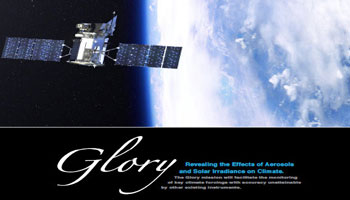The U.S. National Aeronautics and Space Administration (NASA) announced Tuesday that its Glory satellite is scheduled for launch on Friday, March 4.

The March 4 liftoff from Vandenberg Air Force Base, California, is targeted for 5:09 a.m. EST (1009 GMT), in the middle of a 48- second launch window. Spacecraft separation occurs 13 minutes after launch, according to NASA.
The Glory mission will improve NASA's understanding of how the sun and tiny atmospheric particles called aerosols affect Earth's climate. Glory also will extend a legacy of long-term solar measurements needed to address key uncertainties about climate change. It will join a fleet called the Afternoon Constellation or "A-train" of satellites. This group of other Earth-observing satellites, including NASA's Aqua and Aura spacecraft, flies in tight formation.
Glory will carry new technology
designed to unravel some of the most complex elements of the Earth system. The
mission carries two primary instruments, the Aerosol Polarimetry Sensor (APS)
and the Total Irradiance Monitor (TIM).
APS will improve measurement of aerosols, the airborne particles that can influence climate by reflecting and absorbing solar radiation and modifying clouds and precipitation.
TIM will extend a decades-long data record of the solar energy striking the top of Earth's atmosphere, or total solar irradiance. APS will collect data at nine different wavelengths, from the visible to short-wave infrared, giving scientists a much-improved understanding of aerosols. The instrument, NASA's first Earth- orbiting polarimeter, will help scientists distinguish between natural and human-produced aerosols. The information will be used to refine global climate models and help scientists determine how our planet is responding to human activities.
Glory will fly in a low-Earth orbit at an altitude of 438 miles, about the distance from Boston to Washington. After launch, mission operators will conduct verification tests for 30 days and then begin to collect data for at least three years.
VietNamNet/Xinhuanet